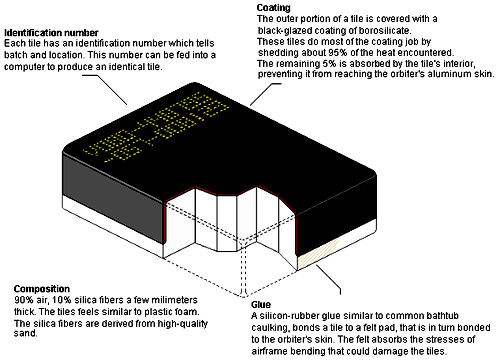High-temperature reusable surface insulation (HRSI)
An HRSI tile. Note the yellow markings, which denote its exact location on the orbiter.
HRSI tiles (black in color) provided protection against temperatures up to 1,260 °C (2,300 °F). There were 20,548 HRSI tiles which covered the landing gear doors, external tank umbilical connection doors, and the rest of the orbiter's under surfaces. They were also used in areas on the upper forward fuselage, parts of the orbital maneuvering system pods, vertical stabilizer leading edge, elevon trailing edges, and upper body flap surface. They varied in thickness from 1 to 5 inches (2.5 to 12.7 cm), depending upon the heat load encountered during reentry. Except for closeout areas, these tiles were normally 6 by 6 inches (15 by 15 cm) squares. The HRSI tile was composed of high purity silica fibers. Ninety percent of the volume of the tile was empty space, giving it a very low density (9 lb/cu ft or 140 kg/m3) making it light enough for spaceflight.[1] The uncoated tiles were bright white in appearance and looked more like a solid ceramic than the foam-like material that they were.
The black coating on the tiles was Reaction Cured Glass (RCG) of which tetrasilicide and borosilicate glass were some of several ingredients. RCG was applied to all but one side of the tile to protect the porous silica and to increase the heat sink properties. The coating was absent from a small margin of the sides adjacent to the uncoated (bottom) side. To waterproof the tile, dimethylethoxysilane was injected into the tiles by syringe. Densifying the tile with tetraethyl orthosilicate (TEOS) also helped to protect the silica and added additional waterproofing.
An HRSI tile. Note the yellow markings, which denote its exact location on the orbiter.
HRSI tiles (black in color) provided protection against temperatures up to 1,260 °C (2,300 °F). There were 20,548 HRSI tiles which covered the landing gear doors, external tank umbilical connection doors, and the rest of the orbiter's under surfaces. They were also used in areas on the upper forward fuselage, parts of the orbital maneuvering system pods, vertical stabilizer leading edge, elevon trailing edges, and upper body flap surface. They varied in thickness from 1 to 5 inches (2.5 to 12.7 cm), depending upon the heat load encountered during reentry. Except for closeout areas, these tiles were normally 6 by 6 inches (15 by 15 cm) squares. The HRSI tile was composed of high purity silica fibers. Ninety percent of the volume of the tile was empty space, giving it a very low density (9 lb/cu ft or 140 kg/m3) making it light enough for spaceflight.[1] The uncoated tiles were bright white in appearance and looked more like a solid ceramic than the foam-like material that they were.
The black coating on the tiles was Reaction Cured Glass (RCG) of which tetrasilicide and borosilicate glass were some of several ingredients. RCG was applied to all but one side of the tile to protect the porous silica and to increase the heat sink properties. The coating was absent from a small margin of the sides adjacent to the uncoated (bottom) side. To waterproof the tile, dimethylethoxysilane was injected into the tiles by syringe. Densifying the tile with tetraethyl orthosilicate (TEOS) also helped to protect the silica and added additional waterproofing.

لینک دانلود فیلم عایق حرارتی ویژه شاتل
122 مگابایت
دانلود کیفیت پایین 31 مگابایتی در ادامه
